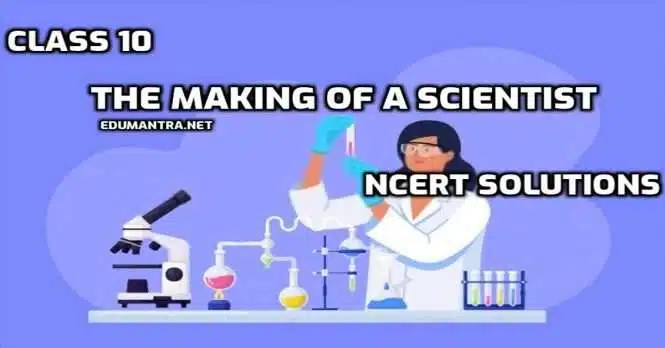
The Making of a Scientist Class 10 NCERT Solutions are written by experts. Go through and gain confidence. We at edumantra highly appreciate your feedback regarding Adverb Clause | Examples & Types.
The Making of a Scientist Class 10 NCERT Solutions
1. How did a book become a turning point in Richard Ebright’s life?
Answer:- Richard Ebright was interested in collecting butterflies. By the time he was in the second grade, he had collected all the twenty-five species of butterflies found around his hometown. This would have been the end of his butterfly collecting. But at this point, his mother got him a book called “The Travels of Monarch X’. This book told him about the migration of monarch butterflies to Central America. This book aroused his interest in Monarch butterflies and opened the world of science to him. This proved to be a turning point in the life of young Richard Ebright. He began to raise Monarch butterflies in the basement of his home, and study them in a different stage of their development.
2. How did his mother help him?
Answer:- Richard Ebright’s mother helped him by encouraging his interest in learning. She took him on trips, bought him telescopes, microscopes, cameras, mounting materials and other equipment, and helped him in many other ways. If he did not have anything to do, she found things for him to learn. Even the book that became a turning point in his life was given to him by his mother. Hence, it can be said his mother played a crucial role in the making of the scientist.
Read and Find Out
1. What lesson does Ebright learn when he does not win anything at a science fair?
Answer: Edbright realizes that mere display of something does not mean science. To win at a science fair he will have to do real experiments.
2. What experiments and projects does he then undertake?
Answer:- He makes experiments to find out what causes the viral disease that kills nearly all monarch caterpillars.
He undertakes a project to test the theory that victory butterflies copy monarchies to survive.
3. What are the qualities that go into the making of a scientist?
Answer:- The author mentions three qualities that go into the making of a scientist—a first-rate mind, curiosity, and the will to win for the right reasons. Richard Ebright was a very intelligent student. He was also a champion debater, a public speaker, a good canoeist and an expert photographer. He always gave that extra effort. He was competitive, but for the right reasons. From the first, he had a driving curiosity along with a bright mind, and it was this curiosity that ultimately led him to his theory about cell life.
Think about It
1. How can one become a scientist, an economist, a historian…? Does it simply involve reading many books on the subject? Does it involve observing, thinking and doing experiments?
Answer:- Reading books is just one aspect of learning. This is an exercise in information gathering. It is how your brain processes the information that affects the degree of learning. The first and the foremost criteria to become a genius in one’s chosen field is to have a great curiosity and unending hunger to discover more. Next criteria is a good sense of observation which helps you to correlate your findings with what you see or experience in the real world.
Experiments are just to test your findings against possible variables and in real life situations. And last, but not the least criteria is an urge to work really hard on your area of interest.
2. You must have read about cells and DNA in your science Discuss Richard Ebright’s work in the light of what you have studied. If you get an opportunity to work like Richard Ebright on projects and experiments, which field would you like to work on and why?
Answer:- Ebright’ work is directly related to Biology. Discovery of a cell’s structure has helped the scientific community to understand the way any organism functions and grows. This has helped scientists to discover how disease-causing organisms attack us and grow inside our body. This must have given the idea to counter a particular disease. DNA fingerprinting is helping police to pinpoint the real culprit. This was not possible when DNA was discovered. Monarch butterflies present an amazing example of a tiny creature migrating thousands of miles from North America to the rainforest of Amazon. Someday we can be in a position to develop as sturdy and reliable navigation system as that of the Monarch butterflies.
Talk about it (Page 38)
- Children everywhere wonder about the world around them. the questions they ask are the beginning of the scientific inquiry. Given below are some questions that children in India have asked Professor Yash Pal and Dr Rahul Pal as reported in their book, Discovered Questions (NCERT, 2006)
(1) What is DNA fingerprinting? What are its uses?
(ii) How do honeybees identify their own honeycombs?
(iii) Why does rainfall in drops?
Can you answer these questions? You will find Professor Yash Pal’s and Dr Rahul Pal’s answers (as given in Discovered Questions) on page 75.
Ans. Students may see the answers to these questions on page 75 of their textbook.
- You also must have wondered about certain things around you. Share these questions with your class, and try to answer them.
Ans. It should be discussed at the class level.
Download Chapter-6 THE MAKING OF A SCIENTIST in PDF